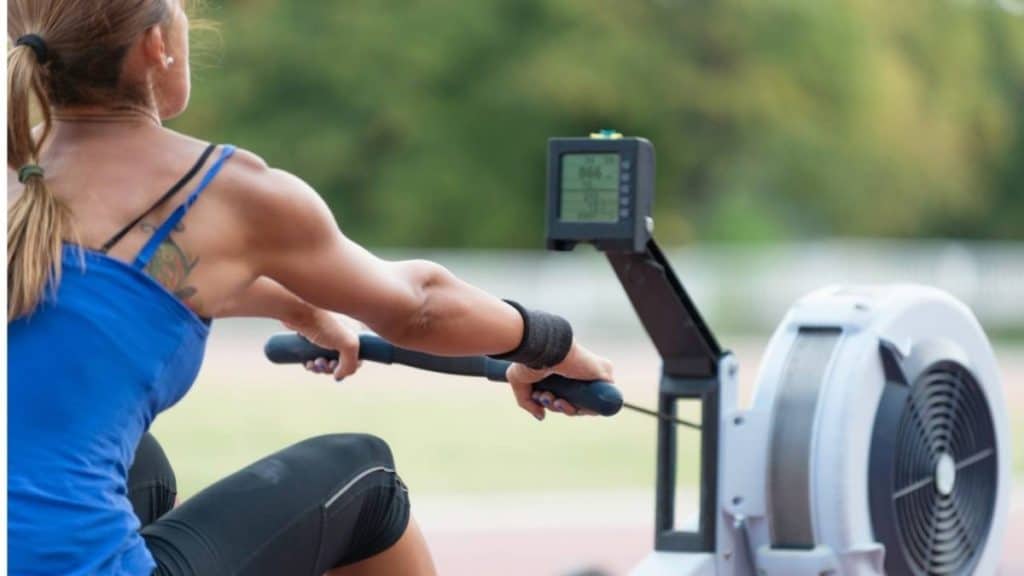
Rowing engages 86% of muscles in the entire body and is a game-changer for losing weight. This exhilarating outdoor activity has become a staple in gyms for fitness. The full-body workout is becoming a preference for many over running or other HIIT exercises. But how much rowing will you need to do to lose weight?
You can burn from 427-714 calories per hour through moderate-paced rowing, depending on your body weight. Rowing is also safer than running for those with injuries, joint problems, and other health or mobility issues.
Rowing properly may become your key to being fit, healthy, and achieving your fitness goals. This article will help explain how you can lose weight through a proper rowing gym routine and what other benefits you’ll get by incorporating rowing into your workout.
Table of Contents
How Does Rowing Help You Lose Weight?

Rowing has a huge thumbs up from medical professionals and fitness trainers as a tried and tested weight-loss method. Not only does it reduce excess fat, but it builds and tones muscles as well.
A crucial element of losing weight through rowing is understanding the technique. Besides your movement in rowing, you must focus on your stroke rate, which is how many complete strokes you perform per minute. This stroke rate determines your pace and how many calories you burn in an hour.
No exercise can give overnight results, but consistently rowing for an hour daily, even five days a week, can help you cut down a pound per week. The results are, of course, subject to your weight, diet, and sleeping habits.
To understand the rate at which you should expect weight loss, you can check the table below:
Weight | Calories Burned (Per Hour) | ||
| Light | Moderate | Vigorous | |
| 135 lb (61 kg) | 214 | 427 | 519 |
| 145 lb (65 kg) | 231 | 462 | 561 |
| 155 lb (70 kg) | 245 | 490 | 595 |
| 165 lb (74 kg) | 263 | 525 | 638 |
| 175 lb (79 kg) | 280 | 560 | 680 |
| 185 lb (83 kg) | 294 | 588 | 714 |
| 195 lb (88 kg) | 312 | 623 | 757 |
| 205 lb (92 kg) | 326 | 651 | 791 |
| 215 lb (97 kg) | 343 | 686 | 833 |
Many other websites and fitness apps can give you accurate estimates of calories burned using your specific diet and workout schedule. You can also consult a professional to help you make a personalized routine and get closer to your fitness goal.
The number of calories you burn depends on the rowing distance and times it take you to compete it. Here are the average times for some of the most popular distances and what times males and females achieve for their age grounds.

Importance of Rest and Diet in Rowing
Proper rest and a healthy relationship with food must go hand-in-hand with rowing and any exercise you do.
Regardless of how motivated you are to become fit, you should never go overboard. It’s recommended to take at least one rest day after 4 consecutive days of rowing. Additionally, you should take proper care of your sore muscles and refrain from doing other strenuous physical activities while resting.
Your diet is also an essential factor, but you shouldn’t compromise on food. As previously mentioned, having a caloric deficit in a controlled manner paired with consistent rowing will give you your desired results in a few months. But strict dieting and food restrictions could hinder your progress.
If a rowing machine is unavailable in your local gym or always occupied, you can invest in buying one for your home. You can find them for prices as low as $299, which are easy to install and maintain.
Rowing is a full-body workout that can help you build muscle, burn calories, and enhance your fitness. But with so many indoor rowers on the market, how do you know which one is right for you? Check out my Top 5 Rowing Machines For 2023

How Much Should I Row a Day to Lose Weight?
If you wanted to lose 1 pound of body weight each week you would need to burn around 500 calories every day. Therefore, you would need to row for 1 hour at a moderate pace every day to achieve this goal. If you want to burn 2 pounds a week it would be 2 hours each day.
The number of hours or days you row per week to lose weight depends on your fitness level, weight, and lifestyle. Cardio exercises like rowing are excellent for active people who want to tone their muscles and improve endurance.
If you lead a sedentary lifestyle and have recently started rowing to become fit, it’s best to row for 30-60 minutes, 3-5 times a week. This timetable will help you ease into a workout routine and see visible results without putting too much pressure on your body.
If you’re looking to lose a lot of weight or want more defined muscles, you can row for 60-90 minutes, 4-6 times a week. This rowing time table is for people who are already comfortable with working out and have some experience with rowing.
The key to any workout plan is consistency. No matter how much you row in a day, week, or month, the only way to see visible results is by being consistent with your timings and listening to your body.

Rowing and Its Benefits
Rowing keeps going up the popularity chain in gyms equipped with a well-maintained machine. That is because the benefits far outweigh any doubt or fear that they have of injury or looking silly in the gym.
Although it isn’t the same experience as doing the real deal in water, this is a more accessible version with less disturbance from nature. Here are some of the benefits of rowing:
1. It’s Inclusive For All
Although rowing seems intimidating, that’s not the case at all. It is a simple and effective method that guarantees fat loss and strength training. You don’t have to be a certain size or at a certain level of fitness to try it out.
The calorie burn and results mainly depend on your starting weight and routine. You don’t have to be a pro to see improvement.

2. The Technique Is Simple
The best part for many is the straightforward technique used in rowing. It’s easy to learn and has minimal injury risk. The steps are named Catch, Drive, Finish and Recover in order.
You begin with the catch in a compressed stance at the foot of the machine holding the handle.
Drive is the extension of the arms and legs as you pull the handle away. You Finish when your body is at full extension and finally, Recover by contracting your legs and bringing yourself to the Catch position again.
The stance or form is pivotal in this exercise. Perfecting it will help your results and keep accidents or mishaps at bay, such as pulling any muscles.
3. It’s a Full-Body Workout
As mentioned before, rowing is one of the few workouts that engage most muscles in the body. This allows an overall change in the body, tackling fat in every place. This is important because although no workout can spot reduce fat, some exercises focus more on one half of the body.
This isn’t necessarily an issue, but it leads to complicated and time-consuming workout routines attempting to engage the whole body.

4. Low Impact With High Results
Most exercises demand too much exertion and force, which leaves people feeling extremely sore. Generally, this soreness isn’t a bad sign, but it translates into consistent aches and other problems.
Rowing doesn’t have that effect and still manages to give you a thorough workout.
This is a big plus for people with previous injuries that can get aggravated or other medical problems that limit their options.
5. Improved Overall Fitness
Fat loss and strength training are the main goals when rowing, but it also has added benefits. Rowing can improve your coordination, balance, and endurance. A daily rowing routine can give you a fit body that is agile and strong.

6. Improved Heart Health
Exercising in general is good for the heart, but rowing takes it up a notch. The heart works overtime when you row since all the muscles are active and need oxygenated blood. A stronger heart can lead to better circulation and improved cholesterol levels. All of this decreases the risk of any heart disease.
7. Improved Posture
Problems with posture are rampant these days because of the many hours people spend hunched over a desk or phone. This causes backaches, neck pain, and general fatigue. Rowing helps to fix this by working on the muscles in the back and shoulders. These are the very same muscles that hunch you over, so it’s a two for one deal.

8. Joint-Friendly
As we age, our joints begin to hurt more and feel strained with every movement. This is because the cartilage that protects them breaks down over time. Low-impact exercises like rowing are the best way to prevent these issues by keeping the joints healthy.
9. Reduces Stress Levels
Working out in general is a great way to relieve stress, but rowing takes it up a notch with its calming and meditative quality. There is something about being on the water and working your body that just makes everything feel better. If you’re looking for an activity to reduce anxiety and improve your mood, rowing is the way to go.

10. It’s Fun!
Rowing can be a fun and social activity. There are many rowing clubs and groups that get together to row for fun or competition. This is a great way to make friends and stay motivated. Rowing can also be a great family activity. It’s a great way to bond and get everyone moving.
11.It’s Easy on the Wallet
Rowing is a very affordable workout. You don’t need much equipment or gear, and you can do it anywhere there is water. This makes it a great option for people who want to workout on a budget.

FAQs
Q. Is Rowing a Difficult Exercise?
No, it is a relatively easy exercise because the technique is simple and self-paced. If you use an indoor rowing machine they have a 1-10 level. So, if your new to rowing you can still get a great workout using the lower levels.
Q. Can You Expect Immediate Results by Rowing on a Strict Diet?
A calorie deficit diet may encourage results. However, strict diets don’t guarantee faster weight loss. The best way to lose weight is by rowing, eating a healthy diet and including strength training.
Q. What Time of Day Should I Row?
The best time to row is in the morning before breakfast. Rowing on an empty stomach will help your body burn more fat for fuel. If you can’t row in the morning, try to row at least 3-4 hours after your last meal.
Q. Is Rowing Indoors the Same as Rowing in Water?
Not entirely. Rowing outdoors requires more energy and other skills such as controlling the paddles, working with waves, etc. But both provide a great workout.
Final Thoughts
Rowing is an effective exercise for burning calories and losing weight. It’s easy for beginners and doesn’t require strenuous or extreme techniques. Due to its popularity, rowing machines are available in most local gyms for you to try.



